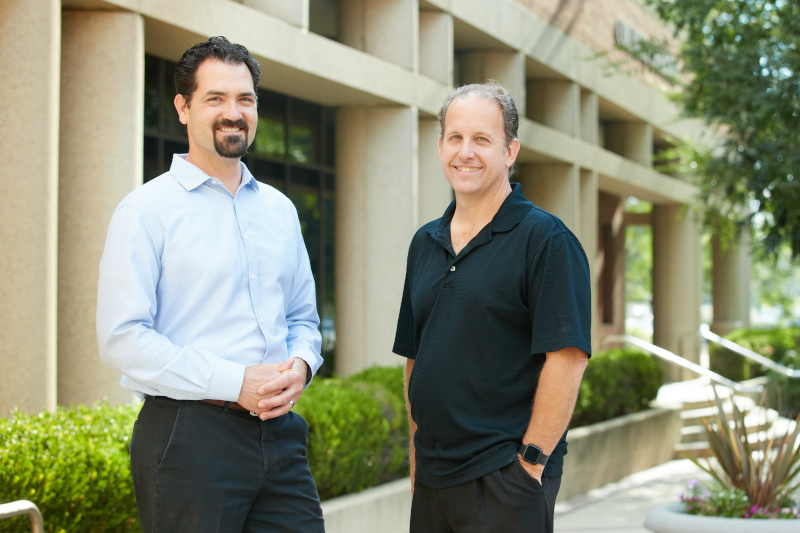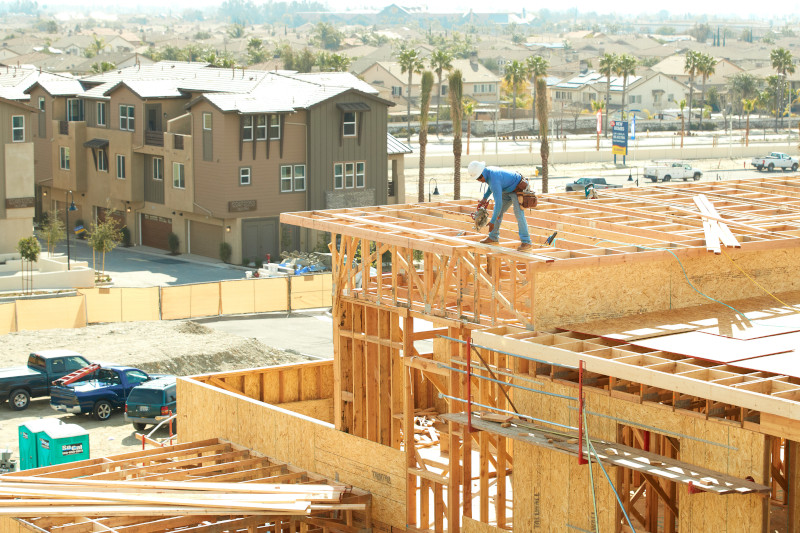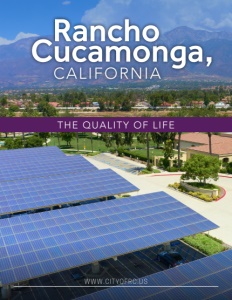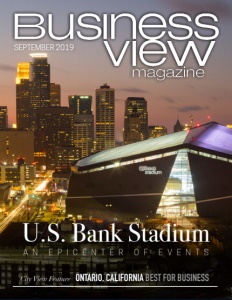Rancho Cucamonga, California
The quality of life
Business View Magazine interviews representatives of Rancho Cucamonga, California, as part of our focus on best practices of American cities.
Rancho Cucamonga is a city of about 180,000 residents located just south of the foothills of the San Gabriel Mountains and Angeles National Forest in San Bernardino County, California. The original inhabitants of the area were the Kukamongan Native Americans who had established a village settlement in the area around present-day Red Hill, near the City’s western border. The name “Kucamonga” derives from a Native American word meaning “sandy place.”
In 1771, Spanish monks of the Franciscan order founded the Mission San Gabriel Arcángel and established the Rancho Cucamonga as a site for grazing their cattle. In 1839, the 13,000-acre rancho was granted by the Mexican governor of California to Tiburcio Tapia, a wealthy Los Angeles merchant. Tapia transferred his cattle to Cucamonga and built a fort-like adobe house on Red Hill. He also established the first winery in California. The Rancho was inherited by Tapia’s daughter, Maria Merced Tapia de Prudhomme, and her husband Leon Victor Prudhomme, and was subsequently purchased by John Rains and his wife in 1858. The Rains family’s home, Casa de Rancho Cucamonga, was completed in 1860 and now appears on the National Register of Historic Places.
During the ensuing years the town around the Rancho prospered and grew. In 1887, irrigation tunnels were dug into Cucamonga Canyon by Chinese laborers and the Santa Fe Railroad was extended through the area. The town’s economic mainstay was agriculture, including olives, peaches, citrus, and, most notably, vineyards. Nearly one hundred years later, in 1977, the unincorporated communities of Alta Loma, Cucamonga, and Etiwanda voted to incorporate, forming the City of Rancho Cucamonga.
Today, Rancho Cucamonga is a thriving community with beautiful neighborhoods, great shopping, and a diverse business sector employing thousands in high wage sectors. It is also a major center for the logistics industry in Southern California.
Recently, Business View Magazine spoke with two representatives of Rancho Cucamonga’s government. City Manager John Gillison detailed some of the City’s recent energy efficiency and infrastructure projects, while Matt Burris, Deputy City Manager for Community and Economic Development, talked about housing and economic development issues. The following is an edited version of that conversation.
BVM: John, can you begin with the City’s two flagship sustainability programs?
Gillison: “In 2012, we partnered with our local council of governments that was doing an initiative where all cities were invited to submit sites that they thought might be feasible for a solar project. At the end of it, Rancho Cucamonga wound up being the only city in the county that moved forward. It’s called Solar RC. We installed a solar energy system at five City-owned sites. That included our Civic Center location and our Central Park, which is our main community and Senior Center. We also put it out at our minor league baseball stadium called the Epicenter – that’s where our Animal Center is, as well. And it went on a couple of our major fire stations.
“We installed this through a direct purchase – we paid, upfront, for the system and that system is going to save us $6 million over the next 25 years. We’ve been quite pleased with it. The initial savings the first couple of years has exceeded what was forecast. Beyond the obvious benefits of reduced impact on the environment and reduced energy usage, we got some great parking/shade structures at a couple of our major parking lots, which really help, both in winter and summer, for people to have a place under shelter to park.
“Paired with that project was our LED street light project. We took over ownership of 15,000 of our street lights from Southern California Edison, and we did that for a couple of reasons. One was that there was a savings on reduced maintenance costs of about 80 percent a year because we were more efficient. The second part of it was after we purchased those lights, we did a full conversion of all 15,000 to LED. That conversion reduced our energy usage by about 66 percent and it further increased the maintenance savings because LEDs have much longer life. And when one LED goes out, you don’t lose an entire street, the way you can with regular bulbs. That project is going to reduce our carbon dioxide emissions by a little over 1,000 metric tons and save us about $1.3 million in energy and maintenance costs over the ten-year lifespan of the project. So, it cost us $3 million to do that, but we will actually save about four times that in energy and maintenance costs. It’s saving us enough money that it’s paying back the money we used upfront to purchase the street lights. So those have been two of our green projects – helping the environment while improving our bottom line.”

City Manager, John Gillison and Deputy City Manager, Matt Burns.
BVM: And the infrastructure projects?
Gillison: “The first is our Fiber Master Plan Project. Rancho Cucamonga took a look at other communities around the country that have done underground, high-speed fiber projects. One of the key takeaways was that with the 21st century economy moving into an information and technology age, the ability for businesses of all kinds – high tech manufacturing, medical services, you name it – to be able to have reliable, cost-effective, high-speed internet service through fiber optic cables, wound up being a huge stimulus to local economies. It helped modernize and revolutionize those cities that have done this in terms of their economic development.
“So, we took a look and realized that we had a lot of pieces of what could be a high-speed fiber network, but we had never put in the effort into joining them all into a complete system and a series of redundant loops. So, we embarked on that project, teaming up with a private sector partner that’s bringing expertise and the customer interface, and, at the end of it, when we’re done, we will have over 60 miles of fiber optic cable throughout the City that will be capable of both upload and download speeds of up to 1 Gigabit. Our focus is, initially, on all our non-residential areas – commercial, office, industrial. And that was actually where our service from the private sector was most deficient. With those high speed fiber connections, we’re already seeing some advanced manufacturing and other businesses locating in town.
“We’re also working on an office corridor, and part of the key to that corridor is having access to this high speed fiber for corporate headquarters, because, again, businesses, these days, are built around access to information in the cloud and having that high speed. And now, we’re going to be able to deliver that service to our businesses.
“Beyond the economic development side, it also lets us tie together our traffic infrastructure. We’ve got hundreds of traffic signals throughout the City, and other traffic control devices, and having them all linked via a high-speed fiber network will let us improve traffic flow, be prepared for autonomous vehicles, and move our street infrastructure into the 21st century, too.
“Related to that is recognizing that traffic and transit, and the ability for commerce to move unimpeded, are key. Rancho sits at the intersection of the 210, 10, and 15 freeways and it’s in a key area in terms of deliveries from the port, logistics, manufacturing, etc. We’re right at about the distance that a fully-loaded truck is going to drive from the port in one day, before it has to drop its merchandise and refuel. So, with that, and with our proximity to a number of railroad lines, has come the complication of how we juggle a lot of freeway traffic, street traffic, and railroad traffic. One of the keys to that is separating the major vehicular corridors from the railroad crossings. That lets the railroad line handle more trains on a daily basis and lets our key street network, especially where it services large logistic centers, flow unimpeded by the railroad traffic – both freight and passenger.
“So, we have a very big project, right now – it’s about a $62 million project to separate rail from car/truck traffic on Etiwanda Avenue, which is the major arterial in our industrial area. We have a number of half-million to million-sq.-ft. warehouses on that corridor, even more if you count our two neighboring cities (Ontario and Fontana), because Etiwanda is the boundary between Rancho and our two neighbors. Right now, the street crosses the railroad at grade, which means that dozens of times a day, we’ve got trains crossing the rail line where Etiwanda Avenue meets the railroad. One of the problems with that is that it can stop traffic anywhere from a minute to ten or fifteen minutes when freight traffic is passing.
“So, with this grade separation, we’re going to take the current at-grade crossing and move it vertically up into the air; we’ll have a bridge that will go up and over the railroad track in both directions. It will be able to handle heavy freight traffic. This will allow the continued expansion of this area; we’ve got a number of undeveloped parcels, which should be able to develop because traffic flow will be improved. It will help expand railroad traffic because one of the concerns we’ve had is growth on the rail line impeding the vehicular flow. We’re still in the design phases on this project; we don’t expect to start construction for about a year, but we’re already seeing some positive results with some key properties in the area that have room for very large facilities, already starting to change hands. And we’ve got people coming in and proposing new projects that might not have been as feasible otherwise. So those are our two key infrastructure projects.”
BVM: Matt, can you talk about the housing and economic development initiatives in the City?
Burris: “Several decades ago, the City leadership articulated the idea that Rancho should be a world-class community. That notion led to several decades of success at creating a place where people wanted to live, work, and raise their children. And a lot of that thinking has carried through into our development projects. We’re seeing the development of a very diverse housing stock in Rancho Cucamonga. A big part of that is recognizing some market demographic shifts occurring in society and the types of places that people want to live, and work, and shop, and play are changing rapidly and very different from the models that we used in decades past.
“We’re seeing a lot more development occur around the idea of creating a lot of diverse places and housing types, providing mixed-use and providing places that are walkable and people-friendly. So, we’re getting a range of housing and development types that are organized around people-first. Some of that is going to be in denser, mixed-use urban formats; some of that we’re seeing in what we might call traditional suburban density. We’ve got somewhere in the neighborhood of 10,000 units in the development pipeline, ranging from recently-approved and under construction, to in the middle of the entitlement process. We’ll see probably six to seven thousand of those 10,000 units developed in the next five or six years, and the remaining three to four thousand will probably develop in the five-plus years past that time frame.

“We’re witnessing the redevelopment of what was a failing private golf course – that project is called The Resort. It’s developing into a mixed-use, urban, pedestrian-friendly series of neighborhoods oriented around our commuter rail and transit station. It’s a series of different housing types in different densities organized in a for-sale and for-rent pattern with services and retail activities.
“We’ve got another large development happening on the other side of the spectrum and the other side of the City. We’re going through a multi-year, community-based planning program to annex 4,300 acres of land into the City. The organizing principle around that effort, which is called the Etiwanda Heights Neighborhood and Conservation Plan, is to bring that 4,000-plus acres into the City limits and balance both development and conservation. If this plan ends up getting approved as it’s currently proposed, we would see the development of about 3,000 new units on about 900 acres, primarily single-family attached and detached, organized in a mixed-use fashion with a village center with retail and services, in a walkable, traditional format. And the balance of 3,100 acres would be conserved as open space in the foothills of the National Forest. So, we’re getting great new neighborhoods that will generate less traffic that we see in conventional neighborhoods; generate less greenhouse gas emissions; and we’re realizing 3,000-plus acres of conserved, open space and all the ecological benefits that come along with that.
“A big part of this initiative is providing a range of housing that’s affordable to the workforce here. On balance, we’re close to being even in terms of the number of employees that we export on a given day and the number of workers that come into the City to work every day, but we have an imbalance in that a lot of the people who live here are working in jobs outside of the City and a lot of the people who are working here, live outside of it. So, a big part of our housing strategy is trying to diversify our housing offerings so that people who do work here have an opportunity to live here.
“Right now, in southern California, we have a pretty severe shortage of affordable and attainable housing. In some ways, that’s an opportunity for us in Rancho Cucamonga because our housing is oftentimes more affordable and more attainable for families that live closer to the coast. We’re not that far from the Pacific coast, but we’re far enough away that there’s a market housing cost differential. On the other hand, we also don’t have a lot of affordable or attainable housing relative to the rest of the region. So, we’re hoping that, through this addition of another 10,000 units, it will reduce the severity of the housing shortage in our City and provide ample opportunities for young professionals and new families to come to Rancho Cucamonga and realize a better quality of life.
“In the same vein, we’re trying to further develop key corridors for office and commerce so that we can provide opportunities for the people who live here to work here in a greater range of jobs. So, the rest of our development effort is focused on a couple of these corridors: we’ve got our Foothill Blvd. corridor, which is Route 66, and that’s intersected by our Haven Avenue corridor. A key part of the City’s long-held vision of an economic development strategy is to take Haven Avenue and help facilitate its development as an office corridor where we would concentrate our professional jobs, tech positions, corporate headquarters, etc., and we already realized a lot of success in the development of that corridor over the last several decades. In this current development cycle, we’re seeing renewed interest in office development, but it’s occurring in a more urban, mixed-use fashion. The idea is that our fiber infrastructure will help support the development of those corporate, and professional, and tech uses of that corridor, and it will be occurring in a more walkable fashion that will reduce dependence on automobiles.
“That last corridor that I mentioned that traverses the City from east to west – our Foothill Blvd. corridor – is anchored on its east by Victoria Gardens, which is the City’s outdoor mall and regional shopping destination. It opened in 2004 and was intended to be the City’s downtown; there’s nothing else like it in southern California. The City held to its vision and waited until it was able to find the right development partner, and we saw the realization of that vision in Victoria Gardens, which is a 1.2 million-square-foot, open air town center organized around a series of blocks so that it looks and feels and functions like a central business district. It’s one of the most successful retail centers in the country and that idea of a high-quality retail center organized around people in a walkable format is helping to anchor the vision for Foothill Blvd. We’re starting to see some of our first, vertical, mixed-use buildings get built on Foothill and we’ve got several projects in the pipeline to develop three and four-story, mixed-use buildings in that walkable, urban format, helping the City to realize the vision of a mix of uses provided through a series of high-quality suburban neighborhoods, all the way up to urban living organized in these mixed-use buildings in an urban corridor.”
BVM: What else would you want our readers to know about Rancho Cucamonga?
Gillison: “Rancho Cucamonga is a relatively young community – we’re just a little over 40 years old. So, one of the benefits of that is that the City has been very carefully planned from the beginning. We are fortunate that we’ve been able to avoid some of the challenges that plague older communities, which developed in the early 1900s, and didn’t benefit from the same level of planning, knowledge, and resources that we have – being able to learn from what others have done. The idea of a City with a plan that’s a world-class community is core to the City’s image. And our challenge, right now, is taking those attributes and moving them into the 21st century, highlighting where technology is taking communities. We’re located in the Inland Empire, but on the western edge of San Bernardino County and about 50 miles from Los Angeles. So, in many ways, we’re much more akin to a beach community in terms of the way we’re growing and developing and trying to attract younger workers and knowledge-focused businesses.”
Burris: “I think one of the most noteworthy things about the City is how successful it has been in focusing on quality of life and understanding how that focus extends beyond just meeting the needs and interests of its residents, but how it can be such an effective economic development strategy. Not only does it help us attract businesses, because we can say it’s such a great place to work, but this guiding light of creating a great place that people want to be, really helps to drive the economy and gives the City a strong foundation for deploying some of our more progressive green and sustainable strategies. They’re so important in how we impact the region, the state, and the rest of the world.”
AT A GLANCE
WHO: Rancho Cucamonga, California
WHAT: A city of 180,000
WHERE: South of the foothills of the San Gabriel Mountains in San Bernardino County
WEBSITE: www.cityofrc.us
PREFERRED VENDORS
Evolution Fresh® – www.evolutionfresh.com
Evolution Fresh® exists to help people thrive and to make every day better than yesterday. We do this by sharing the best of mother nature through our deliciously pure, nutrient-dense and organic fruit and vegetable juices. Established in Southern California in 1995, we set down our roots in the heart of Rancho Cucamonga seven years ago and built our state-of-the-art manufacturing facility. From this one location we produce the highest quality, cold-pressed juice—harvest to bottle is typically less than four days—and distribute throughout all of North America. In partnership with the city and our dedicated employees we’ve continued to grow at scale while maintaining our small-brand craftmanship and quality.
Pacific Utility Installation, Inc – www.pacificutility.com
A General engineering and High Voltage contractor specializing in the installation of underground electric distribution line extensions since 1997, for Municipalities throughout Southern California. PUI provides both on site field service and maintenance along with engineering and design services.
Over the last 22 years Pacific Utility has developed a strong commitment to safety and training which has made them a leader in Professional and readily available staff in all of Southern California.
SNC Solutions – www.snc-solutions.com
SNC was founded in 2010 by partners who understand the critical link between efficiency and the long-term health and sustainability of an organization. Together, the team connected the dots of distribution and logistics experience with the ability to design, engineer, and implement warehouse systems that facilitate the highest levels of efficiency. From simple pallet rack to fully automated warehouses, SNC has built a reputation as the leader in warehouse development and system integration.










